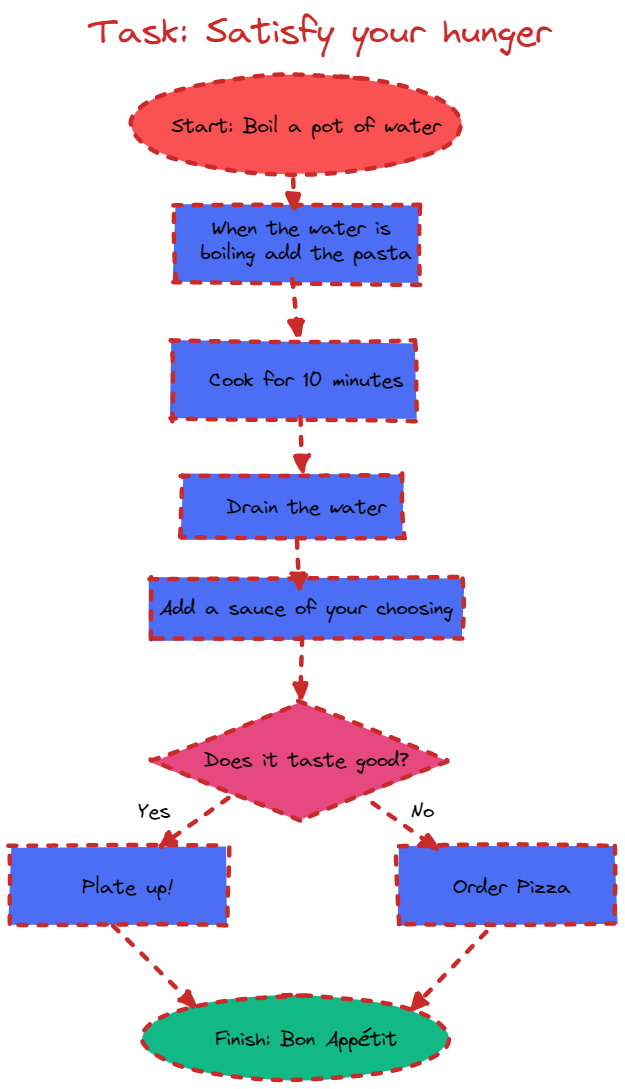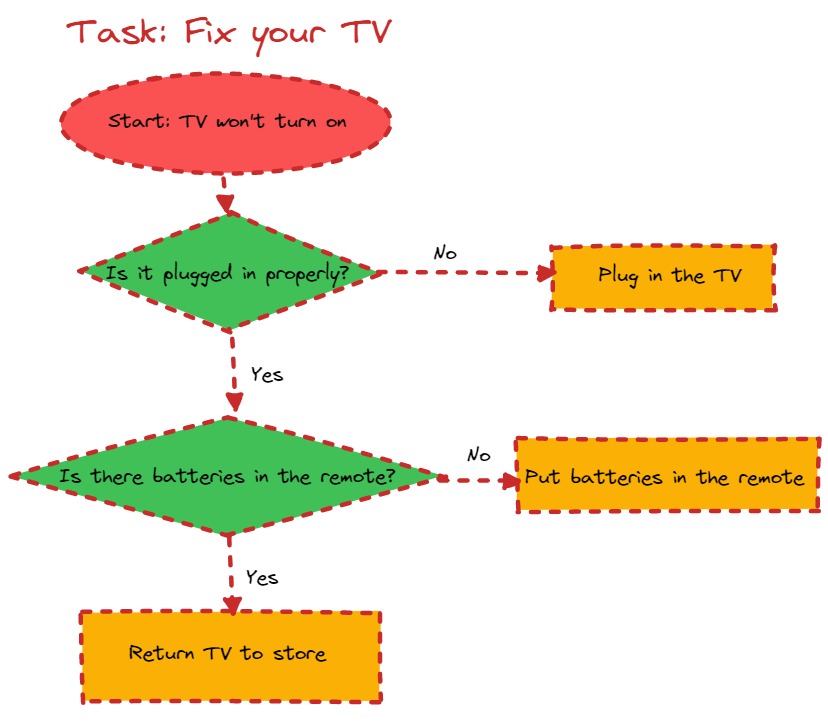Algorithms in Everyday Life
Algorithms are not a recent phenomenon and have existed long before modern computers. We have been using them unknowingly for all our lives and so have our ancestors.
Let’s look at an example of how we use algorithms on a daily basis. You’re hungry. To successfully complete the task of sufficing your appetite you need to eat so you decide to cook. You follow a series of steps in the following order to complete the specified task:
Example 1

This entire process is actually an algorithm. You followed steps in a particular order and as a result reached the desired outcome of a full stomach. Let’s break this down even further with another example, you have just bought a new pristine HD TV. You take it home and to your outrage discover that it won’t turn on. What do you do?
Example 2

The task: Fix the TV
The starting situation: TV won’t turn on
Step (conditional) 1: Check if the TV is plugged in properly, if:
- Yes: Proceed to step 2
- No: Plug in the TV
Step (conditional) 2: Check if there are batteries in the remote, if:
- Yes: Return TV to store
- No: Put the batteries in the remote
Build your intuition. Click the correct answer from the options.
Question: An Algorithm is _
Click the option that best answers the question.
- A procedure for solving a problem
- A problem
- A real-life mathematical problem
- None of the above
Algorithms in Technology
Similarly computers require specific sets of instructions to solve specific problems. You, as the programmer must create these instructions so that the computer will be able to solve these problems. The specific set of instructions (program code) is made up of algorithms.
Netflix’s Algorithms
Did you know that over 80% of what people watch on Netflix comes from the recommendation algorithm? So, what is it that entices us to click on that new TV show, a catchy title, an interesting synopsis, or maybe the thumbnail?
If you compare your friend's Netflix account to your own (that is, if you both are using your own subscriptions), you will notice the thumbnails are quite different. Netflix tailor’s thumbnails to create a truly personalized experiences for each subscriber. According to Netflix the thumbnail is the most important piece of the puzzle to engaging viewers to hit Play since as humans we are intensely visual creatures.
Using a collection of tools and algorithms known as Aesthetic Visual Analysis or Ava for short, Netflix determines the best images for thumbnails from the tons of data it sifts through. To put the magnificence of the data in context an hour-long Stranger Things episode has almost 86,000 video frames.
AVA analyses every static frame of a video creating metadata which helps build a database. An image ranking algorithm then uses the metadata to pick out the most attractive and clickable shots. Using the algorithms selected shots Netflix's creative team then design the thumbnail masterpiece.

Netflix's algorithms will then choose the most suitable thumbnail based on the subscribers viewing habits. From the example, the thumbnail on the left showing Robin Williams, a famous comedian could be shown for subscribers who mainly engage with comedy content while other subscribers more interested in romantic titles could be shown the other thumbnail.
Try this exercise. Click the correct answer from the options.
Netflix uses a collection of tools and algorithms for finding the most suitable thumbnail known as?
Click the option that best answers the question.
- AVE
- AVA
- VAA
- NAV
Google's Algorithms
Let's return to our previous example of cooking the pasta. We will pretend (or not) your culinary skills are not that impressive so in order to prepare the pasta dish you need a recipe. So where is the place that people tend to go with their burning questions? Google of course.
Since the beginning of Google in 1998, it has been continuously mapping the web with hundreds of billions of pages to create something called an index. Similar to a giant library Google looks through these indexes whenever we instigate a search.
The word pasta will show up a lot on the web pages but not always specific to cooking. Pages with the history of pasta, restaurants with the best pasta, types of pasta, and so on will also come up. But right now, you are hungry so clicking through millions of links would be inefficient and frankly agitating if you are a hangry person.
Enter: Google's Ranking Algorithms. Search algorithms look at many factors and signals, including the words of your query, relevance and usability of pages, expertise of sources, and your location and settings. Algorithms also recognize fraudulent sites and flag them. They will then sift through millions of potential matches and assemble a meticulously organized page with the most relevant information in under a secound, enabling you to get started with your cooking.
Let's test your knowledge. Click the correct answer from the options.
Google's search algorithms determine a pages ranking by what factors?
Click the option that best answers the question.
- Words in the query
- Person's location
- Relevance of pages
- All the above
Conclusion
Both humans and computers can use algorithms to perform everyday tasks. The main difference being that computers use algorithms much faster and more efficiently than we can.
Technology is only going to continue to evolve and get even better at what it does. As long as coding and programming continue to be used, algorithms will be at the heart of these technologies guiding what they do and how they do it.
One Pager Cheat Sheet
- We have been unknowingly using algorithms on a daily basis to complete various tasks, from cooking to fixing a
TV, demonstrating thepowerof applying structuredlogicto reach a desired outcome. - An algorithm is a set of instructions written in a
programming languageor pseudocode to solve a specific problem. - Computers need
algorithmsto solve specific problems, so programmers must create the necessary instructions. - Netflix uses
Aesthetic Visual Analysiswith an image ranking algorithm and creative team to customize thumbnails for each subscriber based on their viewing habits, creating a truly personalized experience. - Netflix uses Aesthetic Visual Analysis (AVA) to create
metadatafor every static frame of a video, which the image ranking algorithm uses to select the most attractive and clickable shots that the Netflix creative team design into a thumbnail masterpiece for selection by the subscribers' viewing habits. Google's Ranking Algorithmsuse hundreds of billions of webpages and personalized factors to quicklysift through millions of potential matchesand provide their users with the most relevant information in under a second.- Google's search algorithms strive to quickly and accurately provide the most relevant and accurate results by using a variety of
factors and signals, such as the query words, relevance and usability of the webpages, expertise of their sources, searchers location and settings, and the ability to identify fraudulent sites. - Computers can
executealgorithms much faster and more efficiently than humans, making algorithms a key component in modern technology.



